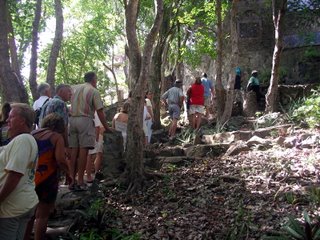
Rodney Bay is over a mile long. At the northern end, an artificial causeway connects Pigeon Island with the mainland, providing the bay with protection. And now there is an enormous Sandals resort there. This was once the main British navy base in the area and on the island was a fort, hospital, barracks etc. The St. Lucia National Trust conserves it as a wonderful park. There are two peaks, one with the fort and the other called Signal Hill. The first photo shows the fort taken from the hill and the second looks back from the fort. Scott and I motored over from the Marina in our dinghy on two different days. The hikes are great and there is a lovely sandy beach. After our hot hike, we jumped in that water very quickly and stayed in a long time. There was even a fresh water shower there to rinse off in afterwards

The Jambe de Bois restaurant is another reason to come here. This charming combination of bar, restaurant, art gallery, hip coffee shop and bookstore is run by a local animal rights activist - and the food is good. They have a jazz group on Sunday and after I fly back to the States today, Scott will be over there tomorrow. Actually he already has plans tonight to hit the local music scene with friends.


The choices for lunch are varied: stuffed potato with shrimp, seafood salad, French bread sandwiches, roti, grilled fish, lamb curry etc. We came prepared the second time with six books to trade as they have one of the best book exchanges we've seen. This is a cruiser specialty - marinas, restaurants and other establishments that cater to the boating community have shelves where people leave old books and pick up new.
 The selection here was wide; classics, mysteries, science fiction and thrillers. The first three are my favorites and Scott likes the last. But this place also had non fiction, magazines, and foreign language books. This is a place where you can hang out for a long time. Of course the view outside isn't bad either.
The selection here was wide; classics, mysteries, science fiction and thrillers. The first three are my favorites and Scott likes the last. But this place also had non fiction, magazines, and foreign language books. This is a place where you can hang out for a long time. Of course the view outside isn't bad either.


















































